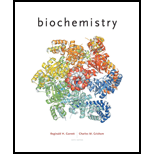
Interpretation :
standard Gibbs free energy and Gibbs free energy for the gluconeogenesis in the erythrocytes should be calculated.
Introduction :
In gluconeogenesis glucose is produced from the non-carbohydrate substances. This is an anabolic reaction and can be considered as the reverse of the catabolic reactions. For this question, generation of glucose from pyruvate is considered. This reaction sequence can be considered as the reverse of the glycolysis that occurs with the help of set of anabolic enzymes and energy carrier molecules.
Explanation of Solution
All the reactions in glycolysis are reversed in the gluconeogenesis. However, energy of the reactions that occur with hexokinase, phosphofructokinase, and pyruvate kinase enzymes changes depending on the ATP, ADP, Pi, GTP and GDP concentrations. Therefore, ΔG values changes. For other reactions, ΔG values can be obtained by reversing the sign of the respective values indicated in 18.1 table as they are the reverse reactions.
ΔGfor conversion of Pyruvateto PEP
ΔGofor the conversion of PEP to pyruvate is
That is the ΔGofor the reverse reaction.
ΔGfor conversion of Fructose-1,6-bisphosphate to fructose-6-phosphate
F6P = fructose-6-phosphate
F1,6BP = Fructose-1,6-bisphosphate
ΔGfor conversion of glucose-6-phosphate to glucose
G6P = glucose-6-phosphate
Therefore, with the other values final ΔG for the entire process,
Want to see more full solutions like this?
Chapter 22 Solutions
OWLv2, 1 term (6 months) Printed Access Card for Garrett/Grisham's Biochemistry Technology Update, 6th
- role of iron (Fe) in human body by focusing on Structure-Function-Location• how much of FE is present in your body? • what does it do? • where is it found? how long can you survive these conditions, before you will manifest first signs of physiological/psychological (either one, maybe both?) pathology? What will be those symptoms? Can you tell what is the natural cycle of Fe in your body?arrow_forwardQuestion:- Explain why it makes sense for the PDH complex in liver to be active when dephosphorylated.arrow_forwardCatabolism - draw the complete citric acid cylcle for myristatearrow_forward
- Activity of pesin in the blood at pH 7.4arrow_forwardUnderstanding the Oxidation of Glucose and Its Products in the TCA Cycle Glycolysis, the pyruvate dehydrogenase reaction, and the TCA cycle result in complete oxidation of a molecule of glucose to CO2. Review the calculation of oxidation numbers for individual atoms in any molecule, and then calculate the oxidation numbers of the carbons of glucose, pyruvate, the acetyl carbons of acetyl-CoA. and the metabolites of the TCA cycle to convince yourself that complete oxidation of glucose involves removal of 24 electrons and that each acetyl-CoA through the TCA cycle gives up 8 electrons.arrow_forwardRegulation mechanism for hexokinase 1 and hexokinase IVarrow_forward
- Diabetes Type 1 and Type 2 Applying signal transduction mechanisms in the context of Type I and Type II Diabetes. Describe the mechanisms by which a cell receives a message and translates it into short-term or long-term effects. Including the role of phosphorylation and feedback inhibition.arrow_forwardComparison of Fetal and Maternal Hemoglobins.Studies of oxygen transport in pregnant mammals show that the O2-saturation curves of fetal and maternal blood are markedly different when measured under the same conditions. Fetal erythrocytes contain a structural variant of hemoglobin, HbF, consisting oftwo a and two g subunits (α2γ2), whereas maternal erythrocytes contain HbA (α2β2). a)Which hemoglobin has a higher affinity for oxygen under physiological conditions, HbA or HbF? Explain. b)What is the physiological significance of the different O2 affinities? c)When all the BPG is carefully removed from samples of HbA and HbF, the measured O2-saturation curves (and consequently the O2affinities) are displaced to the left. However, HbA now has a greater affinity for oxygen than does HbF. When BPG is reintroduced, the O2-saturation curves return to normal, as shown in the graph. What is the effect of BPG on the O2affinity of hemoglobin? How can the above information be used…arrow_forwardMatching :1. MDR protein Part of NAD molecule ______ 2. SGLT Part of FAD molecule _____ 3. Grb-2 Raises intestinal pH _______ 4. Cholecystokinin Oxidizes C-C bonds ___________ 5. Chylomicron Has higher phosphoryl transfer potential than ATP __ 6. Secretin An ABC transporter ______ 7. Niacin Sodium-glucose symporter ______ 8. Flavin Lipoprotein complex ______ 9. FAD Found in EGF pathway _____ Phosphoenolpyruvate Signals release of digestive enzymesarrow_forward
- Effects of BPA on phosphorylation of cPLA2 in RAW264.7 cells conclusionarrow_forwardExplain EPHB2 receptor interaction with PDZ-binding. Give full explanantionarrow_forwardUncoupling of the oxidative phosphorylation (2,4-dinitrophenol,thyroid hormones, free fatty acids), their biomedical value.arrow_forward
 BiochemistryBiochemistryISBN:9781305577206Author:Reginald H. Garrett, Charles M. GrishamPublisher:Cengage Learning
BiochemistryBiochemistryISBN:9781305577206Author:Reginald H. Garrett, Charles M. GrishamPublisher:Cengage Learning
